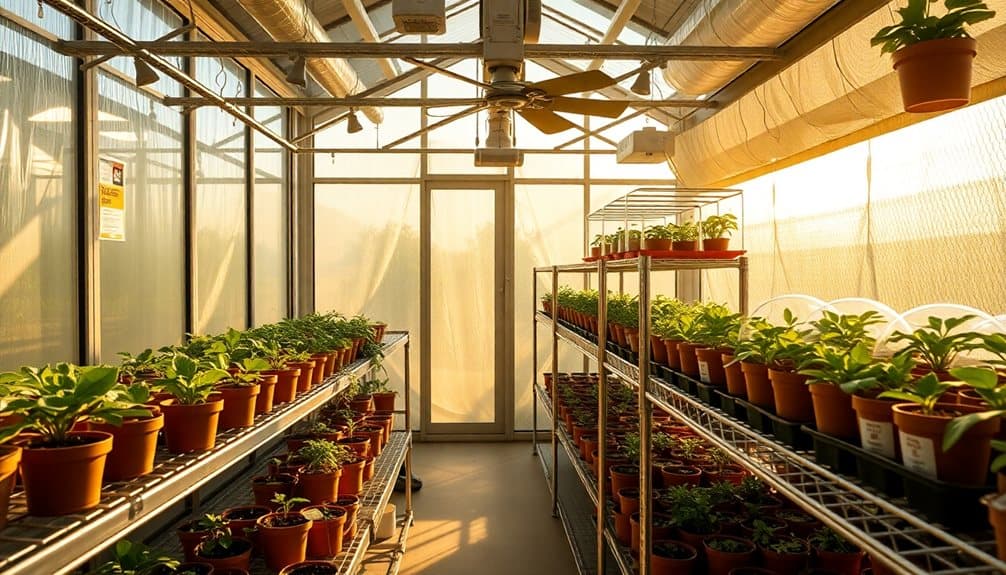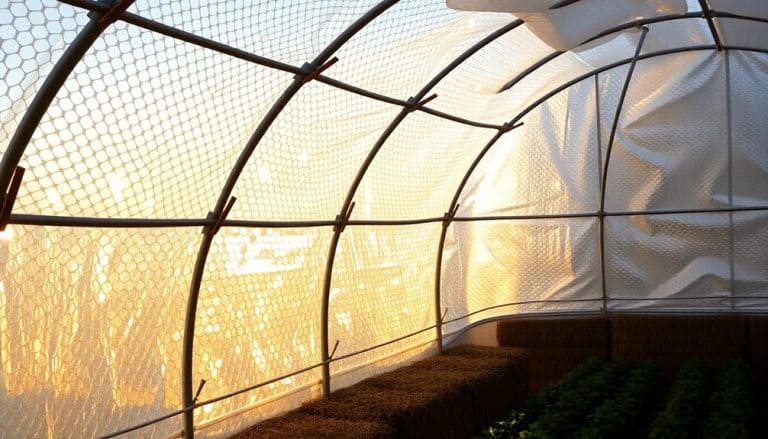This website contains affiliate links. Some products are gifted by the brand to test. As an Amazon Associate, I earn from qualifying purchases. The content on this website was created with the help of AI.
You’ll need essential greenhouse accessories to maintain ideal growing conditions year-round. Start with automated ventilation systems featuring thermostat-controlled exhaust fans and intake shutters for precise temperature control (75-85°F). Install LED grow lights positioned 12-36 inches above plants to supplement winter lighting, providing PAR of 400-700 nanometers. Incorporate digital monitoring equipment for temperature and humidity tracking, plus automated irrigation systems with soil moisture sensors. Add thermal screens and double-wall polycarbonate panels (R-value 1.7-2.0) for insulation. Understanding these technical specifications will enhance your greenhouse’s efficiency and productivity potential.
Key Takeaways
- LED grow lights with adjustable heights and customizable spectrums provide essential supplemental lighting during dark winter months.
- Automated ventilation systems with thermostat-controlled exhaust fans maintain optimal temperature and reduce disease pressure year-round.
- Digital temperature and humidity monitors with data logging capabilities ensure consistent growing conditions through all seasons.
- Multi-tier, galvanized steel shelving maximizes vertical growing space while ensuring proper air circulation between plants.
- Automated irrigation systems with moisture sensors deliver precise watering control across different growing zones and seasons.
Automated Ventilation and Cooling Systems

Automated ventilation and cooling systems serve as essential temperature control mechanisms within the greenhouse environment. These systems utilize thermostat-controlled exhaust fans, intake shutters, and circulation fans to maintain ideal growing conditions. When temperatures exceed predetermined thresholds, the system activates automatically, expelling hot air while drawing in cooler air from outside.
You’ll need to position your exhaust fans at the highest point of your greenhouse, where hot air naturally accumulates. Install intake shutters on the opposite end at a lower level to create effective cross-ventilation. The system’s control panel should include adjustable temperature settings, typically ranging from 75-85°F (24-29°C), depending on your crop requirements.
For enhanced efficiency, you’ll want to integrate horizontal air flow (HAF) fans that maintain consistent air circulation throughout the growing space. These operate continuously, preventing temperature stratification and reducing disease pressure. Modern systems also incorporate humidity sensors, which work in tandem with temperature controls to maintain optimal vapor pressure deficit (VPD) levels. Through careful calibration of these components, you’ll achieve precise environmental control for year-round cultivation. An effective ventilation system can reduce disease risk by preventing excess moisture buildup and maintaining proper airflow throughout your greenhouse.
Grow Lights for Winter Production
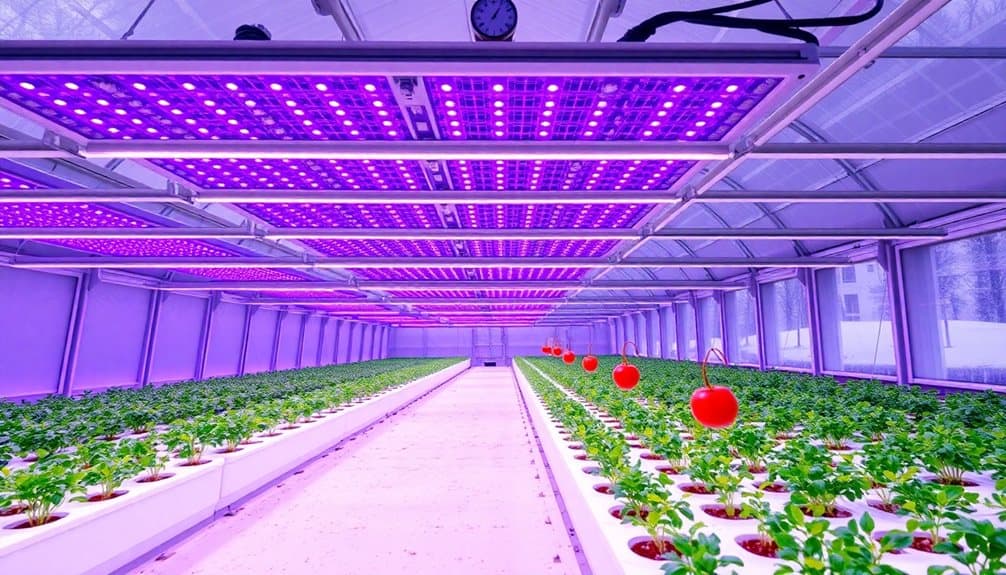
Supplementing natural light with artificial grow lights enables continuous greenhouse production throughout winter’s shorter daylight hours. LED grow lights have emerged as the most energy-efficient and spectrum-specific option for winter cultivation, offering photosynthetically active radiation (PAR) values between 400-700 nanometers. You’ll need to calculate your daily light integral (DLI) requirements and position lights to achieve ideal photon flux density for your specific crops.
Modern LED systems allow you to customize light spectrums for different growth stages:
- Blue spectrum (450-495nm) triggers compact vegetative growth and strengthens stems, essential for seedling development
- Red spectrum (620-750nm) promotes flowering and fruit production, considerably impacting yield potential
- Full-spectrum combinations that include UV and far-red wavelengths enhance plant defense mechanisms and photo-morphogenesis
When installing your grow light system, mount fixtures 12-36 inches above plant canopies, depending on light intensity and crop requirements. You’ll want to implement a timer system to maintain consistent photoperiods, typically providing 12-16 hours of supplemental lighting. Monitor leaf temperature and adjust height accordingly to prevent light stress or burning. A 25-watt LED fixture can provide the equivalent light output of a 200-watt incandescent bulb while keeping energy costs manageable.
Temperature Monitoring Equipment

Beyond lighting management, precise temperature control determines greenhouse growing success. You’ll need reliable monitoring equipment to maintain ideal growing conditions and prevent temperature-related crop damage. Digital thermometers with minimum/maximum recording capabilities serve as your baseline monitoring tool, while wireless sensors enable remote temperature tracking via smartphone applications.
For extensive climate control, install a combination temperature and humidity monitor with data logging capabilities. These devices track temporal variations and alert you when parameters exceed preset thresholds. Position multiple sensors at different heights and locations to account for thermal stratification and identify microclimates within your greenhouse structure.
Professional-grade monitoring systems often incorporate soil temperature probes, which are vital for seed germination and root development. You’ll want to integrate automated ventilation controls that respond to temperature fluctuations, particularly in zones where sensitive crops are cultivated. Consider investing in infrared thermometers for spot-checking leaf surface temperatures, as these readings can indicate plant stress before visible symptoms appear. When selecting monitoring equipment, prioritize devices with calibration certificates and verify they’re rated for greenhouse environments where humidity levels typically exceed 80%. Modern wireless thermometers can provide data storage capacity of up to two years, allowing for comprehensive analysis of seasonal temperature patterns.
Irrigation and Watering Solutions
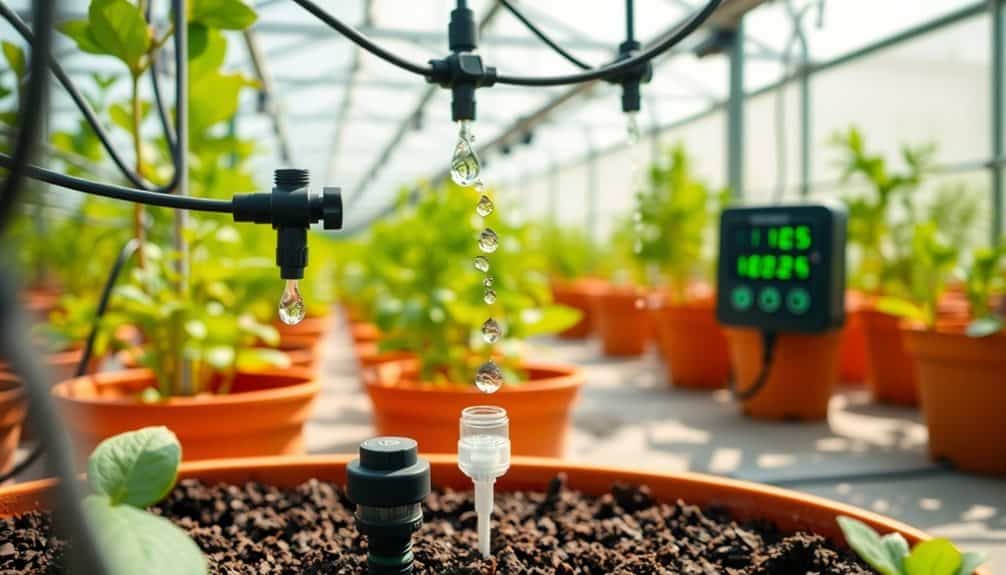
Within any greenhouse environment, efficient irrigation systems form the cornerstone of successful year-round cultivation. You’ll need to implement a precise watering strategy that maintains ideal soil moisture levels while preventing common issues like root rot and fungal proliferation. Modern irrigation solutions incorporate automated systems with programmable controllers, soil moisture sensors, and specialized distribution networks. High-quality UV-resistant tubing is essential for ensuring your irrigation system remains durable and effective against outdoor weather conditions.
Your greenhouse’s irrigation infrastructure should include a combination of drip lines, micro-sprinklers, and misting systems, each serving specific purposes in plant hydration. These components work synergistically to maintain relative humidity levels while delivering water directly to root zones with maximum efficiency.
- Install a dual-zone drip irrigation system with pressure-compensating emitters to guarantee uniform water distribution across varying elevations (±2% accuracy)
- Deploy hygroscopic moisture sensors at 15cm soil depth, connecting to your central control unit for real-time substrate monitoring
- Implement a high-pressure fog system (operating at 1000 psi) for humidity control and foliar feeding capabilities
Shelving and Storage Options
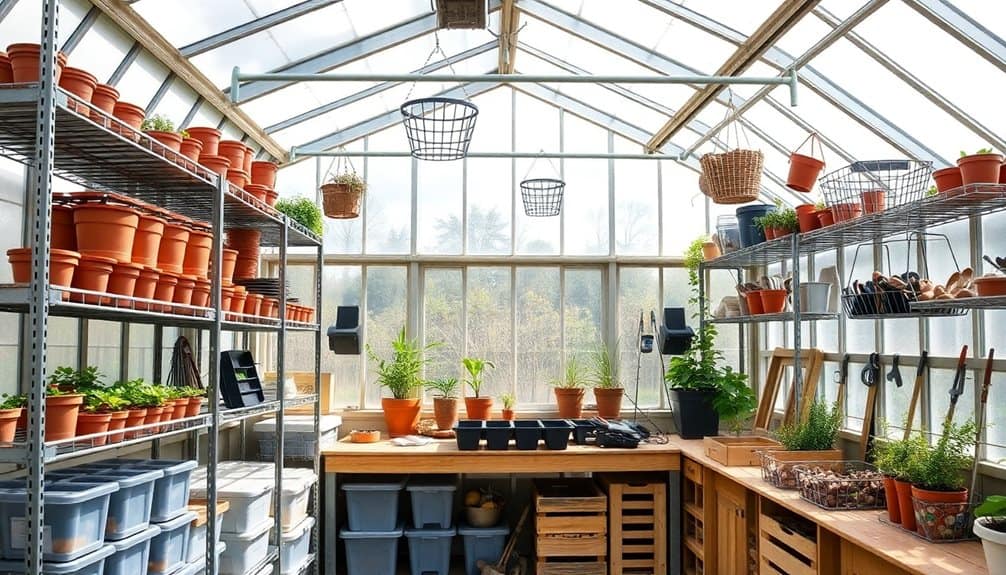
Effective greenhouse storage infrastructure requires a systematic approach to vertical space utilization and load-bearing capacity enhancement. You’ll need to calculate your maximum load requirements and select shelving materials that can withstand both weight distribution and humidity exposure. Galvanized steel or aluminum shelving systems offer superior durability with corrosion resistance, while maintaining structural integrity under varying environmental conditions.
For maximizing spatial efficiency, implement a tiered shelving configuration with adjustable height settings. Standard measurements should accommodate 18-24 inch depths for seedling trays and 36-48 inch lengths for mature plant positioning. Install wall-mounted bracket systems that can support modular components, allowing for seasonal adjustability based on your cultivation requirements.
Consider incorporating specialized storage solutions: germination shelves with heating capabilities, segregated zones for tools and supplies, and dedicated areas for soil medium storage. You’ll want to maintain a minimum of 24 inches between shelving units for adequate air circulation and accessibility. Integrate utility hooks and pegboard systems for hanging tools, and implement drawer units with moisture-resistant properties for storing sensitive equipment and documentation. Label all storage zones systematically for efficient inventory management and workflow enhancement. Essential greenhouse benches provide a stable foundation for your growing operation while maximizing available workspace.
Climate Control Shade Screens

Installing climate control shade screens serves three critical functions in greenhouse operations: solar radiation management, temperature regulation, and humidity control. These retractable systems utilize specialized fabric materials with specific light transmission and reflection properties to enhance your growing environment throughout seasonal variations.
When selecting shade screens, you’ll need to evaluate factors like porosity ratings, energy-saving coefficients, and light diffusion capabilities. Modern shade screens feature aluminum strips woven into polyester threads, creating a precise balance between light penetration and heat reduction. The screens’ deployment can be automated through environmental controllers that monitor real-time conditions.
- You’ll experience up to 75% reduction in solar heat gain during peak summer temperatures, preventing crop stress and reducing cooling costs.
- Your plants will benefit from enhanced light diffusion, creating uniform growth patterns and preventing localized heat spots.
- You’ll maintain ideal vapor pressure deficit levels through controlled humidity management, reducing disease pressure.
For maximum efficacy, position your shade screens 8-12 inches below the greenhouse covering, ensuring adequate air circulation while maintaining thermal efficiency. The system should include lateral tension mechanisms to prevent sagging and maintain uniform coverage across your growing space.
Heating and Insulation Equipment
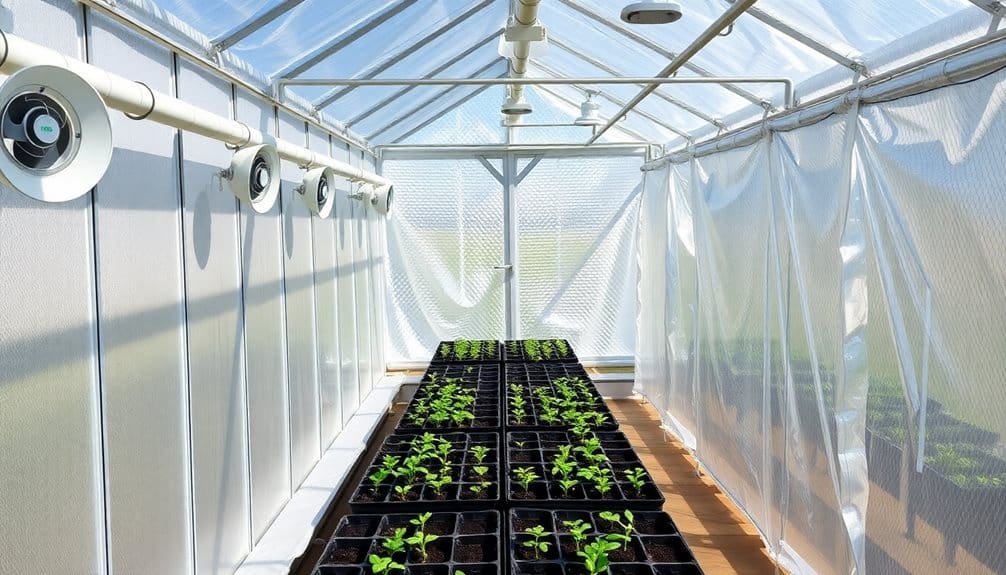
Thermal efficiency in greenhouse operations hinges on properly configured heating and insulation equipment that maintains ideal growing temperatures year-round. You’ll need to implement a multi-layered approach to temperature regulation, combining active heating systems with passive insulation solutions.
For active heating, you’ll want to install forced-air heaters or hydronic systems with programmable thermostats. These units should provide 20-25 BTUs per square foot of growing space in cold climates. Infrared heating panels offer supplemental warmth directly to plant surfaces, improving energy efficiency by 15-20% compared to conventional systems.
Your insulation strategy should incorporate double-wall polycarbonate panels (R-value 1.7-2.0) or thermal bubble wrap (R-value 1.1) for the greenhouse envelope. Install thermal screens that you can deploy at night, reducing heat loss by up to 40%. Don’t forget to seal all gaps with weather stripping and apply foam insulation to exposed metal frames.
Monitor temperature gradients using digital sensors placed at plant height. You’ll need to maintain a temperature differential of no more than 5°F between growing zones while ensuring proper air circulation with horizontal air flow fans.
Frequently Asked Questions
How Much Does It Cost to Maintain a Greenhouse Annually?
You’ll find the annual greenhouse maintenance costs can vary dramatically, ranging from $500 to $3,000. Your primary expenses include heating ($200-1,500), ventilation ($100-300), irrigation ($150-400), and structural repairs ($50-800). Temperature regulation typically consumes 70-80% of operational costs. Additional variables affecting your budget include climate zone, greenhouse size, crop selection, and automation level implemented in your growing system.
What Permits Are Required to Build a Greenhouse in Residential Areas?
You’ll need to obtain several permits before constructing a residential greenhouse: a building permit, zoning permit, and potentially HOA approval. Check your local municipality’s building codes for specific requirements regarding structure size, setbacks, and height restrictions. Some jurisdictions classify greenhouses as accessory structures, requiring compliance with lot coverage regulations. Contact your city’s planning department to verify exact permit requirements and structural specifications.
Can I Convert My Existing Garden Shed Into a Greenhouse?
You can convert your garden shed into a greenhouse through a systematic structural modification process. Begin by reviewing the shed’s orientation for ideal solar exposure and evaluating the foundation’s stability. You’ll need to replace wall panels with transparent polycarbonate or glass materials, install proper ventilation systems, and integrate thermal mass elements. Verify the existing frame can support the new glazing materials’ weight and consider adding supplemental structural reinforcement if necessary.
Which Greenhouse Plants Are Most Profitable to Grow Commercially?
Like mining for green gold, growing profitable greenhouse crops requires strategic planning. You’ll find the highest returns from specialty tomatoes, microgreens, herbs, and exotic orchids. Cannabis offers substantial profits in legal markets, while hydroponic lettuce and bell peppers maintain steady commercial value. Focus on crops with quick maturation cycles and high price-per-square-foot ratios. Consider supplementing with seasonal cut flowers and rare succulents to maximize revenue streams.
How Long Does a Typical Greenhouse Structure Last Before Needing Replacement?
Your greenhouse’s lifespan varies considerably based on its construction materials and maintenance. A high-quality aluminum or galvanized steel frame can last 40-50 years, while polyethylene covering typically needs replacement every 5-7 years. Glass panels endure 30+ years when properly maintained. You’ll need to replace wooden frames every 10-15 years due to moisture damage. Environmental factors like UV exposure, wind loads, and snow accumulation will impact durability.

